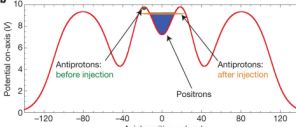HOW DID THEY DO IT?
The physicists combined positrons and antiprotons in beginning with 30,000 antiprotons cooled to 200? above absolute zero, or 200 kelvin, and 2 million positrons cooled to about 40 kelvin.The experiment took place inside a magnetic trap known as an Ioffe-Pritchard trap.report online today in Nature.
That trap was only ‘deep’ enough to capture the slowest-moving antiatoms.
After mixing the protons and positrons, the trap was turned off and electric fields used to sweep any remaining charged particles out the device.
They then turned off the magnetic trap and looked for any lingering antiatoms drifting into the material and annihilating to produce detectable particles.
In 335 trials, the physicists saw a total of 38 trapped atoms—about one every 10 trials.
Physics breakthrough as scientists at CERN capture atoms of elusive ‘antimatter’ for first time

Starship Enterprise takes on a Klingon warship in Star Trek. The spacecraft used antimatter to power its ‘warp drive’
Now scientists say they have captured a sample of real-life antimatter for the first time.
In an astonishing breakthrough, a team of British and international physicists were able to ‘trap’ 38 atoms of anti-hydrogen in a laboratory for a fraction of a second.
While the experiment is unlikely to lead to the warp engines, anti-matter drives or the faster than light travel of Star Trek, it could shed light on the nature and origins of the Universe.
Antimatter is the mirror of ordinary matter. Normal atoms are made up of positively-charged nuclei orbited by negatively-charged electrons.
However, their antimatter counterparts are the wrong way round. They have negative nuclei and positively-charged electrons.
When matter and antimatter meet they instantly annihilate each other, releasing a burst of energy.
Since it was first proposed by the British physicist Paul Dirac in 1931, antimatter has been a staple of science fiction.
Read moreCERN Scientists Capture Atoms Of Elusive ‘Antimatter’ For First Time
